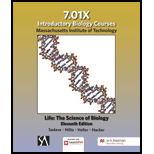
Concept explainers
To review:
The given deoxyribonucleic acid (DNA) sequences of two patients and to identify the kind of mutation and its effect in the protein formed after translation.
Given:
The coding sequences of beta-globin gene of two individuals suffering from mild anemia.
Person 1:
Person 2:
Introduction:
Mutation is essentially any persistent change in the
In case of a frame-shift mutation, a nucleotide is either added or deleted resulting in a complete change of the reading frame. Nonsense mutation refers to the kind, in which any codon, originally coding for a particular amino acid now codes for a stop codon due to a change in the nucleotide sequence.
Explanation of Solution
In the given coding sequences of person 1, the second sequence has a modified 10th nucleotide with respect to the first sequence. It has ‘T’ instead of ‘C.’ On converting this to ribonucleic acid (RNA) sequences, and then assigning amino acid to the codon in a reading frame, it was deduced that the 4th codon containing the transcribed 10th nucleotide was changed from GUC to AUC.
Thus, in the first sequence, the 4th codon coded for valine (amino acid) and the 4th codon of the second sequence coded for isoleucine (amino acid). Since a change in one nucleotide has resulted in a change in an amino acid of the protein chain it is missense mutation. The original amino acid chain is glycine-threonine-tryptophan-valine-serine-lysine and the changed amino acid sequence is glycine-threonine-tryptophan-isoleucine-serine-lysine.
Similarly, for the second person, the second sequence is modified by deletion of the 4th nucleotide. This has completely changed the reading frame. Now on translation, only the first codon is same in both the amino acid sequences. This is a type of frameshift mutation. The original amino acid chain is glycine-threonine-tryptophan-valine-serine-lysine and the changed amino acid sequence is glycine-threonine-tryptophan-isoleucine-serine-lysine.
Thus, it can be concluded that in the 2nd sequence of person 1, the nucleotide sequence has undergone a missense mutation resulting in different protein chain (glycine-threonine-tryptophan-isoleucine-serine-lysine). In the 2nd sequence of person 2, the nucleotide chain has been altered by a frameshift mutation resulting in glycine-threonine-tryptophan-isoleucine-serine-lysine amino acid sequence.
Want to see more full solutions like this?
Chapter 15 Solutions
LIFE:SCIENCE OF BIOL.(LL) >CUSTOM<
- You intend to insert patched dominant negative DNA into the left half of the neural tube of a chick. 1) Which side of the neural tube would you put the positive electrode to ensure that the DNA ends up on the left side? 2) What would be the internal (within the embryo) control for this experiment? 3) How can you be sure that the electroporation method itself is not impacting the embryo? 4) What would you do to ensure that the electroporation is working? How can you tell?arrow_forwardDescribe a method to document the diffusion path and gradient of Sonic Hedgehog through the chicken embryo. If modifying the protein, what is one thing you have to consider in regards to maintaining the protein’s function?arrow_forwardThe following table is from Kumar et. al. Highly Selective Dopamine D3 Receptor (DR) Antagonists and Partial Agonists Based on Eticlopride and the D3R Crystal Structure: New Leads for Opioid Dependence Treatment. J. Med Chem 2016.arrow_forward
- The following figure is from Caterina et al. The capsaicin receptor: a heat activated ion channel in the pain pathway. Nature, 1997. Black boxes indicate capsaicin, white circles indicate resinferatoxin. You are a chef in a fancy new science-themed restaurant. You have a recipe that calls for 1 teaspoon of resinferatoxin, but you feel uncomfortable serving foods with "toxins" in them. How much capsaicin could you substitute instead?arrow_forwardWhat protein is necessary for packaging acetylcholine into synaptic vesicles?arrow_forward1. Match each vocabulary term to its best descriptor A. affinity B. efficacy C. inert D. mimic E. how drugs move through body F. how drugs bind Kd Bmax Agonist Antagonist Pharmacokinetics Pharmacodynamicsarrow_forward
- 50 mg dose of a drug is given orally to a patient. The bioavailability of the drug is 0.2. What is the volume of distribution of the drug if the plasma concentration is 1 mg/L? Be sure to provide units.arrow_forwardDetermine Kd and Bmax from the following Scatchard plot. Make sure to include units.arrow_forwardChoose a catecholamine neurotransmitter and describe/draw the components of the synapse important for its signaling including synthesis, packaging into vesicles, receptors, transporters/degradative enzymes. Describe 2 drugs that can act on this system.arrow_forward
- The following figure is from Caterina et al. The capsaicin receptor: a heat activated ion channel in the pain pathway. Nature, 1997. Black boxes indicate capsaicin, white circles indicate resinferatoxin. a) Which has a higher potency? b) Which is has a higher efficacy? c) What is the approximate Kd of capsaicin in uM? (you can round to the nearest power of 10)arrow_forwardWhat is the rate-limiting-step for serotonin synthesis?arrow_forwardWhat enzyme is necessary for synthesis of all of the monoamines?arrow_forward
 Human Biology (MindTap Course List)BiologyISBN:9781305112100Author:Cecie Starr, Beverly McMillanPublisher:Cengage Learning
Human Biology (MindTap Course List)BiologyISBN:9781305112100Author:Cecie Starr, Beverly McMillanPublisher:Cengage Learning Biology (MindTap Course List)BiologyISBN:9781337392938Author:Eldra Solomon, Charles Martin, Diana W. Martin, Linda R. BergPublisher:Cengage Learning
Biology (MindTap Course List)BiologyISBN:9781337392938Author:Eldra Solomon, Charles Martin, Diana W. Martin, Linda R. BergPublisher:Cengage Learning Human Heredity: Principles and Issues (MindTap Co...BiologyISBN:9781305251052Author:Michael CummingsPublisher:Cengage Learning
Human Heredity: Principles and Issues (MindTap Co...BiologyISBN:9781305251052Author:Michael CummingsPublisher:Cengage Learning Biology Today and Tomorrow without Physiology (Mi...BiologyISBN:9781305117396Author:Cecie Starr, Christine Evers, Lisa StarrPublisher:Cengage Learning
Biology Today and Tomorrow without Physiology (Mi...BiologyISBN:9781305117396Author:Cecie Starr, Christine Evers, Lisa StarrPublisher:Cengage Learning





